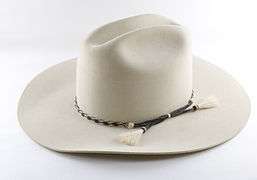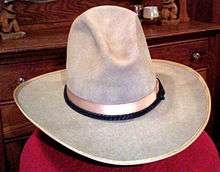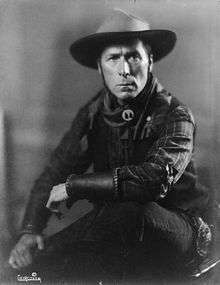Cowboy hat


The cowboy hat is a high-crowned, wide-brimmed hat best known as the defining piece of attire for the North American cowboy. Influenced by 19th century Mexican culture, today it is worn by many people, and is particularly associated with ranch workers in the western and southern United States, western Canada and northern Mexico, with country-western singers and ranchero singers in Mexico, and for participants in the North American rodeo circuit. It is recognized around the world as part of Old West lore. The shape of a cowboy hat's crown and brim are often modified by the wearer for fashion and to protect against weather.
It is an item of apparel that can be worn in any corner of the world, and receive immediate recognition as part of North American cowboy culture.[1]
The first western model was the open-crowned "Boss of the Plains", and after that came the front-creased Carlsbad, destined to become “the” cowboy style.[2] The high-crowned, wide-brimmed, soft-felt western hats that followed are intimately associated with the cowboy image.[3]
Design

Modern cowboy hats are made of fur-based felt, straw or, less often, leather. They are sold with a tall, rounded crown and a wide flat brim. They have a simple sweat band on the inside to stabilize the fit of the head, and usually a small decorative hat band on the outside of the crown. Hats are customized by creasing the crown and rolling the brim. Often a more decorative hat band is added. In some places, "stampede strings" or "wind strings" are also attached.[4] Hats can be manufactured in virtually any color, but are most often seen in shades of beige, brown and black. Beginning in the 1940s, pastel colors were introduced, seen often on hats worn by movie cowboys and rodeo riders.[5] "Today's cowboy hat has remained basically unchanged in construction and design since the first one was created in 1865 by J.B. Stetson."[1]
History

The concept of a broad-brimmed hat with a high crown worn by a rider on horseback can be seen as far back as the Mongolian horsemen of the 13th century.[6] A tall crown provided insulation, the wide brim, shade. Hot, sunny climates inspire designs with very wide brims such as the sombrero of Mexico.
It is not clear when the cowboy hat began to be named as such. Westerners originally had no standard headwear. People moving West wore many styles of hat, including top hats, derbies, remains of Civil War headgear, sailor hats and everything else.[7][8] Contrary to popular belief, it was the bowler and not the cowboy hat that was the most popular in the American West, prompting Lucius Beebe to call it "the hat that won the West".[9] The working cowboy wore wide-brimmed, high-crowned hats that were most likely adopted from the Mexican Vaqueros before the invention of the modern design.[10] However, original cowboy hats originated in Northern Mexico and the Stetson hats came later. Credit for the American cowboy hat as it is known today is generally given to John Batterson Stetson.[11]
The original "Boss of the Plains", manufactured by Stetson in 1865, was flat-brimmed, had a straight sided crown, with rounded corners.[12] These light-weight, waterproof hats, were natural in color, with four-inch crowns and brims.[13] A plain hatband was fitted to adjust head size.[14] The sweatband bore Stetson’s name.[7] While only making one style of hat, they came in different qualities ranging from one-grade material at five dollars apiece to pure beaver felt hats for thirty dollars each.[15] J.B. Stetson was the first to market the "Boss of the Plains" to cowboys, and it has remained the universal image of the American West.[16] The charisma of the West was carried back East when adventurers returned in the expensive “Boss of the plains” style hat.[17] In the 19th century and first half of the 20th century, a hat was an indispensable item in every man’s wardrobe. Stetson focused on expensive, high-quality hats that represented both a real investment for the working cowboy and statement of success for the city dweller.

The durability and water-resistance of the original Stetson obtained additional publicity in 1912, when the battleship USS Maine was raised from Havana harbor, where it had sunk in 1898. A Stetson hat was found in the wreck, which had been submerged in seawater for 14 years. The hat had been exposed to ooze, mud, and plant growth. However, the hat was cleaned off, and appeared to be undamaged.[18]
Modern designs
.jpg)
Ornamentation, such as bows or buckles, are attached on the left side. Historically this had a practical purpose. Because the majority of people are right-handed, in the absence of a wide brim, bows or feathers on the right side of headwear could interfere with the use of weapons.[6]
Inside the cowboy hat is a memorial bow to past hatters, who developed brain damage from treating felt with toxic mercury (which gave rise to the expression "Mad as a hatter"). The bow on the inside hatband at the rear of the hat resembles a Skull and crossbones.[19] "Early hatters used mercury in the making of their felt. Their bodies absorbed mercury, and after several years of making hats, the hatters developed violent and uncontrollable muscle twitching. The ignorance of the times caused people to attribute these strange gyrations to madness, not mercury.”[6]
The modern cowboy hat has remained basically unchanged in construction and underlying design since the Stetson creation.[1] The cowboy hat quickly developed the capability, even in the early years, to identify its wearer as someone associated with the West.[20] "Within a decade the name John B. Stetson became synonymous with the word "hat", in every corner and culture west of the Mississippi."[21] The shape of the hat's crown and brim were often modified by the wearer for fashion and to protect against weather by being softened in hot steam, shaped, and allowed to dry and cool. Felt tends to stay in the shape that it dries.[22] Because of the ease of personalization, it was often possible for people to tell where a cowboy hat was from, right down to which ranch, simply by looking at the crease in the crown.[16]

Later as the mystique of the "Wild West" was popularized by entertainers such as Buffalo Bill Cody and western movies starring actors such as Tom Mix, the Cowboy hat came to symbolize the American West.[23] John Wayne christened them "the hat that won the West".[3] The Boss of the Plains design influenced various wide-brimmed hats worn by farmers and ranchers all over the United States. Later designs were customized for law enforcement, military and motion pictures.
The first American law-enforcement agency to adopt Stetson’s western hat as part of their uniform was the Texas Rangers.[24] A Stetson-based design is also part of the ceremonial uniform of the Royal Canadian Mounted Police.[25] Presidents Harry Truman, Dwight Eisenhower, and Lyndon B Johnson wore cowboy hats manufactured by Stetson.[24]
Creases in cowboy hats are used to give hats individual character and to help users identify with a particular subculture. Creases and dents make it easier to don or remove the hat by grasping it by the crown rather than the brim. A very popular crease used on modern cowboy hats is the Cattlemen. It is creased straight down the center of the crown with a dent on each side. Returning in popularity is the Carlsbad crease, now often called a "Gus crease" after the character Gus McCrae in Lonesome Dove. It maintains a high crown at the back with the crease sloping steeply toward the front. The rodeo crease, the bullrider's crease (Formerly called the RCA crease, for the Professional Rodeo Cowboys Association), the quarter horse crease, and the “tycoon", with a pinched front, are also seen today.[26]
"Ten-gallon" hat

Some cowboy hats have been called "ten-gallon" hats. The term came into use about 1925.[27] There are multiple theories for how the concept arose.
One theory is that the term "ten-gallon" is a corruption of the Spanish modifier tan galán, which loosely translates as "really handsome"[28] or "so fine". For example, un sombrero tan galán translates as "such a fine hat".
Another theory is that the term "ten-gallon" is a corruption of the Spanish term galón, which means "galloon", a type of narrow braided trimming around the crown, possibly a style adapted by Spanish cowboys. When Texas cowboys misunderstood the word galón for "gallon", the popular, though incorrect, legend may have been born. According to Reynolds and Rand, "The term ten-gallon did not originally refer to the holding capacity of the hat, but to the width of a Mexican sombrero hatband, and is more closely related to this unit of measurement by the Spanish than to the water-holding capacity of a Stetson.”[29]
Stetson hat company boasted that the tight weave of most Stetsons hats made them sufficiently waterproof to be used as a bucket. Early print advertising by Stetson showed a cowboy giving his horse a drink of water from a hat.[30] However, even the Stetson company notes that a "ten-gallon" hat holds only 3 quarts (about 3 l instead of 40 l).[29][31]
Regardless, using a hat as a water container is apt to seriously damage a modern hat. On one hand, fur felt hats were designed in part so they could be used in the rain. However, wool felt hats were designed for dry climates, and most straw hats can only handle a light rain for a brief time.[32] While a very high quality felt hat made from animal fur may hold water,[29] over time, any cloth container will leak. Furthermore, modern hats may react to getting wet differently, though this depends on the quality of the materials used in construction. They are generally likely to lose shape and the felt may also soften up if they are completely drenched.[33]
See also
Footnotes
- 1 2 3 Reynolds and Rand, p. 8.
- ↑ Foster-Harris, p. 106.
- 1 2 Snyder, p. 5.
- ↑ Christian, needs page #
- ↑ Snyder, p. 27.
- 1 2 3 Bender, p.#
- 1 2 Carlson, p.#
- ↑ Cowboyhathistory.org. Web page.
- ↑ The Hat That Won the West, retrieved 2010-02-10
- ↑ Bender, p. 11.
- ↑ Sobey, Edwin J.C. Young Inventors at Work! Learning Science by Doing Science (1999) p. 95. ISBN 0-673-57735-X.
- ↑ Snyder, p. 73.
- ↑ Snyder, p. 51.
- ↑ Bender, p. 54.
- ↑ Snyder, p. #
- 1 2 Reynolds & Rand, p. 17.
- ↑ Snyder, p. 49.
- ↑ John B. Stetson Company (1927) Stetson Hats the World Over. The Story of 50 Years of Stetson Foreign Business. Philadelphia, Pennsylvania: John B. Stetson Company .
- ↑ Snyder, p. 32.
- ↑ Reynolds & Rand, p. 10.
- ↑ Bender, p. 12.
- ↑ The Fedora Lounge. Web site..
- ↑ Reynolds & Rand, p. 15.
- 1 2 Snyder, p. 10.
- ↑ "History" at Hitching post.net. Web site.
- ↑ Blevins, p. 371.
- ↑ Bender, p. 31.
- ↑ "'The Story of Spanish' offers a rich history of the language". Los Angeles Times. Retrieved 8 June 2013.
- 1 2 3 Reynolds & Rand, p. 11.
- ↑ Snyder, p. 11.
- ↑ Frequently asked questions, Stetson Hat Company. Web site.
- ↑ "The CanadianCowboy.com Hat Guide" CanadianCowboy.com. Accessed December 30, 2010
- ↑ "How to Take Care of Your Hat" Stampede Tack and Western Wear. Accessed August 9, 2014
References
- Bender, Texan Bix. (1994) Hats & the Cowboys Who Wear Them. ISBN 1-58685-191-8
- Blevins, Winfred. Dictionary of the American West: over 5,000 terms and expressions from Aarigaa! to Zopilote (2001) ISBN 1-57061-304-4
- Carlson, Laurie. (1998) Boss of the plains, the hat that won the West. ISBN 0-7894-2479-7
- Christian, Mary Blount. (1992) Hats off to John Stetson 1992 ISBN 0-02-718465-X
- Foster-Harris, William (2007) The Look of the Old West: A Fully Illustrated Guide ISBN 1-60239-024-X
- Reynolds, William and Rich Rand (1995) The Cowboy Hat book. ISBN 0-87905-656-8
- Snyder, Jeffrey B. (1997) Stetson Hats and the John B. Stetson Company 1865-1970. ISBN 0-7643-0211-6
External links
![]() Media related to Cowboy hats at Wikimedia Commons
Media related to Cowboy hats at Wikimedia Commons